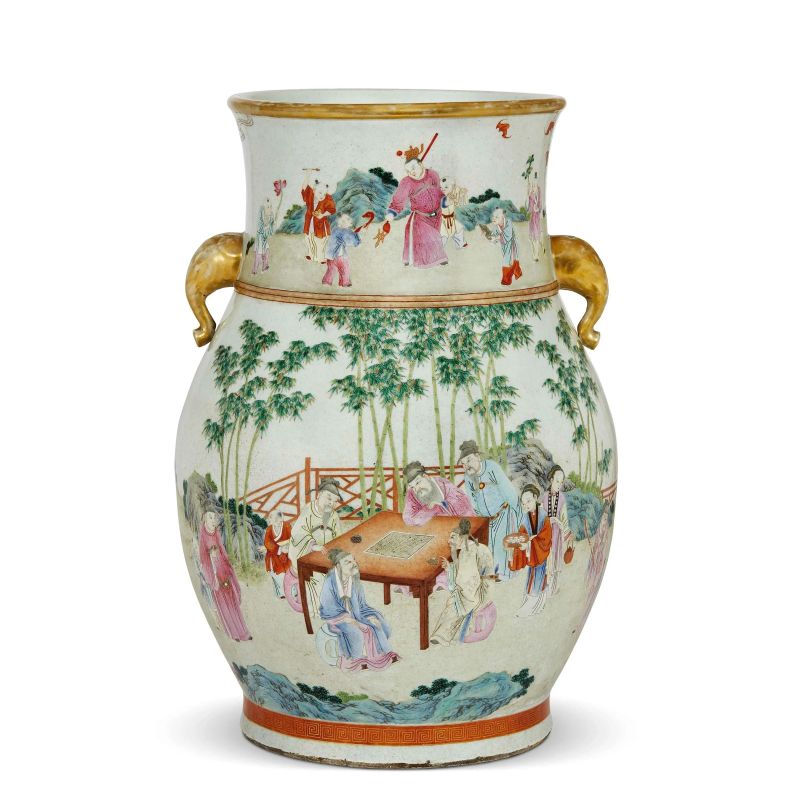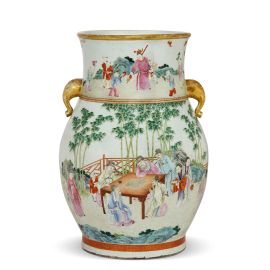A VASE, CHINA, QING DYNASTY, 18TH-19TH CENTURY
in porcelain from the Rose family, in the shape of a Hu painted on the outside with figures, depicting a continuous scene with a cultural event. A sage is teaching children to play a musical instrument in the open air; other figures are playing chess with two elephant-shaped grips. There are also deities around the neck of the three-star vase Fu lu Shou, happiness, wealth and long life.
清 十八至十九世纪 粉彩琴棋书画人物故事纹象耳大尊 高57厘米
以通景图的方式记录了明清雅集文化的场景,文人雅士于竹林旁,长者正在教孩子演奏乐器;另一些文人在对弈。颈部绘有福禄寿三星人物。
VASO, CINA, DINASTIA QING, SEC. XVIII-XIX
in porcellana della famiglia Rosa, a forma di Hu, raffigurante una scena all'esterno con figure impegnate in un evento culturale.Un saggio sta insegnando a suonare uno strumento musicale ai bambini all’aria aperta; altre figure stanno giocando a scacchi con due sedie a forma di elefante. Il collo è dipinto con tre stelle Fu lu Shou indicanti felicità, ricchezza e lunga vita.
Alt. cm 57
The scenes painted on this rare porcelain vase from the Qing dynasty depict people of all ages dressed in traditional Chinese attire gathering in bamboo gardens, with some intellectuals playing the guqin, others being served by women, and children playing happily outdoors, creating a light and joyful atmosphere. These scenes reflect the way in which ancient scholars cultivated friendship through literature and made moral progress with it; this thought later became the foundation for the development of the culture of literary gatherings (雅集, yají). These were not just simple meetings, but sophisticated events featuring elegant display items and delicious dishes to share and eat. During these occasions, intellectuals engaged in various activities such as playing the guqin, playing chess, admiring paintings, tasting tea, performing improvised calligraphy and poetry composition, etc., all with the purpose of entertaining and showcasing the artistic skills of the participants. These were often important people of the time who attended these meetings to showcase and critique art, socialize, exchange ideas, and immerse themselves in culture and art on a daily basis.
这件稀世的清代粉彩瓷器上绘有竹园雅集,文人抚琴对弈,童子嬉戏,女眷奉茗,氛围高雅怡悦。古代学者以文会友,以友辅仁。雅集活动的空间有着讲究的场地布置、精致的陈设用器以及美味的佳肴,席间即席挥毫、吟写诗词等展现文人艺能的部分,参与者也多是当代名流。雅集作为古代知识分子的交往方式之一。在宴会上 文士间在思想和艺能方面相互激荡与较劲,甚、多经典佳作即诞生于此,雅集亦可说是孕育文化与艺术的摇篮。
Le scene dipinte su questo raro vaso di porcellana della dinastia Qing raffigurano persone di tutte le età vestite con abiti tradizionali cinesi che si riuniscono in giardini di bambù, con alcuni intellettuali che suonano il guqin, altri che vengono serviti da donne e bambini che giocano felicemente all'aperto, creando un'atmosfera leggera e gioiosa. Queste scene riflettono il modo in cui gli antichi studiosi coltivavano l'amicizia attraverso la letteratura e progredivano moralmente con essa; questo pensiero divenne poi la base per lo sviluppo della cultura degli incontri letterari (雅集, yají). Questi non erano solo semplici incontri, ma eventi sofisticati che presentavano oggetti di esposizione eleganti e piatti deliziosi da condividere e consumare.
Durante queste occasioni, gli intellettuali si impegnavano in varie attività come suonare il Guqin(古琴), giocare a scacchi, ammirare dipinti, degustare tè, eseguire calligrafie improvvisate e comporre poesie, ecc., tutto con lo scopo di intrattenere e mostrare le capacità artistiche dei partecipanti. Spesso si trattava di persone importanti dell'epoca che partecipavano a questi incontri per mostrare e criticare l'arte, socializzare, scambiare idee e immergersi nella cultura e nell'arte quotidianamente.








